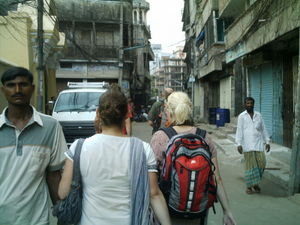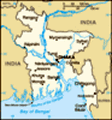Advertisement

 Old Dhaka
Old Dhaka
My flatmate, Ali, is on the left and a Finnish friend, Maria, who works for the World Food Program is on the right. This is a random spot on the outskirts of Old Dhaka that gives you a random shot of an unexciting Dhaka scene. A friend, Rich, is in the background. Friday I found myself going past car-packed white mosques to a centuries-old quiet church. Located in the heart of Old Dhaka, the Armenian church is a remnant from a forgotten past when the Armenians (bizarrely enough) become powerful landowners in Bangladesh. Being the oldest of Christian societies, the Armenians brought their religion with them over the Asian continent and built this church centuries ago. It stands as one of the few churches left in Dhaka among thousands of mosques.
It’s not easy to find if you come to Dhaka. Old Dhaka is low-lying along the windy and wide Buriganga River. What one’s initial visual (and visceral) image of Dhaka is Old Dhaka. It’s third world, overpopulated city life at its purest. The streets are narrow, winding, unmarked, and unpaved. There is nothing but people, animals, and rickshaws packing the streets. There is little electricity and certainly no generators (in a country with several hour-long power cuts a day, it’s a luxury we often don’t appreciate). Along the streets are tall old building, which are lined by vendor after vendor selling everything from mangoes and jackfruit to seashell bangles to lungis (traditional male cloth wraps). Behind the vendors are deep

 Armenian church1
Armenian church1
My flatmates, Ali and Luke, looking at some of the graves at the Armenian church in Old Dhaka.dark rooms that if you look down you’ll see openings into damp homes and some small courtyards. Often craftsmen sit way in the back whittling wood and other items while chatting away in Bengali. Rickshaws plow through the streets, constantly ringing their bells so you aren’t suddenly taken out by shockingly colorful bicycle-drawn carriage. One old man comes up to us and says in Bengali, “Don’t take rickshaws! They are bad!” He clearly has not left Old Dhaka in some time.
We gather a crowd quickly in Old Dhaka—much quicker than in other parts of Dhaka and much much quicker than in Gulshan, my district. We didn’t have many beggers come up to us but people just stare at you in amazement. It’s something that I can never get used to. Everywhere in Dhaka you’ll have people just point-blank staring at you out of pure curiosity. Kids will call to you and go into hysterical laughter when you call back. At one point in that day (in Banani, near Gulshan), some rickshaws gathered around us (hoping we’d become customers). Then some beggers joined the lot and some random people hanging around. Then a vendor selling homemade potato chips seasoned

 Armenian church 2
Armenian church 2
Australian friend, Rich, who works for Dhaka Project, at the Armenian church.with curry powder came around we stood around with them all eating the chips and waiting for our friend. When you’re in a good mood and not alone, it’s amusing. I hear in the villages, it’s beyond one’s comprehension how much attention you draw as a white person. There really are not tourists here and there are not businessmen and fewer foreign NGO workers outside of Dhaka. In Old Dhaka, we quickly generated a pack of boys and men (women never look at you or follow you or you know, act not demurely). They’re completely fascinated by us and since it’s not rude in their culture to stare, stare they do. It’s relatively harmless, though it causes hesitation to pull out your camera or something (which is why I have no pictures of the streets in Old Dhaka). But when we needed a rickshaw and started to hail one down, they all started calling with us to get one. And when we needed to find the Armenian church in the maze of Old Dhakan streets, they were quick to point us in the right direction of the “
Chreeshten moshque.”
In a city of inescapable noise and crowds, the Armenian

 Armenian church3
Armenian church3
A really nice grave left by an Armenian lady who really loved her husband.church is a peaceful haven. It is now maintained by an old Bangladeshi Christian and his son. There is a small old graveyard with most of the stones carved in Armenian with some in English. There is also a beautiful garden with blossoming trees. The church itself is very simple and beautiful with old, dark wooden chairs as pews and winding black stairs up to the balcony. At the altar lay two small piles of sand in which you can light a candle and place it in the sand to glow. Since it was a Friday, the Muslim holy day, we could still hear the calls for
namaj--prayer-- being called out over mosque loudspeakers throughout the day, but it was diminished within the building. And it’s all calling to the same God anyway.
After leaving the church, we made our way to Mother Teresa orphanage in Old Dhaka. (Mother Teresa did most of her work in Kolkata/Calcutta, the closest major city to Dhaka.) We couldn’t take photographs there (though I’ve found a couple on the internet taken by others). It was much less depressing than you might initially think. It is run by nuns and the other workers are

 Armenian church4
Armenian church4
Another shot of the grave--a very rare thing in Dhakausually mothers of the orphans. When a pregnant woman comes there who is not able to care for her child, in return for being able to give birth there and have the child cared for, the woman must stay and work at the orphanage. It appears to be a successful system. There are everything from newborns to kindergarten age and they are just overwhelmingly cute. The ones who can walk run up to you with their arms outstretched begging to be picked up. I would carry them around, swing them around making airplane noises, and point to different objects asking in Bengali what they were and what color. Like every child, they are in love with affection and it’s probably the most detrimental part of growing up that orphans miss. The babies would lie in their cribs and start giggling and kicking when I would tickle their feet and do raspberries with my lips. Babies are babies everywhere. It was hard because when you would leave them, they would cry. And it’s a bit heartbreaking that they aren’t crying out of whining or even hunger, but rather the strong desire for attention and love. Some of the children are a

 Armenian church5
Armenian church5
The steeple of the church. Hopefully it is able to continually be maintained.bit sicker but at least here they are well taken care of so it is not so bad as you will see at ICDDR,B’s hospital, for example.
On the lower floor are children with disabilities. Whether they be mental or physical, they are grouped together in one room. Usually these children are older, some even into pubescence. They lie in large cribs or beds and generally don’t do much else. They appear to have general retardations for the most part—ailments that in our country would be handled completely differently. The nuns here do the best they can. It’s emotionally draining I think to be around it but they are the ones who need attention and affection the most. When I sit next to one girl and smile and tickle her a bit she sits up with a big smile on her face. It’s hard to leave. It’s hard to think of what will happen to them. I wonder if they will even live long or whether eventually they will be out on the street being pimped out as beggars. They won’t be adopted. That being said, if you are interested in adopting a baby or a child or know

 Armenian church6
Armenian church6
This is me in front of the Armenian church, rockin one of my salwar kameez.someone who is, I'm still not completely clear about their adoption policy, but last I heard they aren't doing international adoptions. When I asked a nun she said they were but she either misunderstood me or they've changed their policies. I do know they are open to adoptions within Bangladesh.
After the orphanage, we walked down Hindu Street in Old Dhaka, which is a famous street packed with Hindu craftsmen often selling homemade seashell bangles and little Hindu shrines. I think it must be the most packed street on Dhaka and must contain every Hindu in the entire district. I’ll try to find a picture, but it won’t do it justice since all of your senses are completely overwhelmed, for good and for worse.
It was then that we left Old Dhaka and headed back up to Gulshan in a CNG (mini taxi). We stopped by Westix, a rare western clothing store. Going from one place to the next was unimaginably different. Suddenly I find myself being greeted in English to a highly air conditioned store playing pop music. It’s really “quite smart,” as my English friends put it. That evening, my friends and I got dressed up

 Armenian church7
Armenian church7
The altar of the church.in formal western attire (wrapped up so our knees and shoulders don’t show when we’re outside) and headed over in a rickshaw to the British High Commission in the Baridhara district. A James Bond Casino Royale black-tie party was being held. We were greeted with a glass of champagne (impossible to get here) and some gambling chips. Never did I expect to come to Bangladesh and mingle with such “poshers” (once again, the words of an English friend). I was told some U.S. Marines were there (the ones who guard the American Embassy). It would actually have been interesting to get to meet some of them, but not highest on my list. I did have a good time, though, and enjoyed learning how to properly play roulette and blackjack. (Also something I never expected to pick up in Bangladesh…) Anyway, amidst the tuxes and gowns, the salmon-caper hor d’oeuvres and the high-stakes blackjack table, I felt such an impression of what different worlds lay within Dhaka. You could say the same about New York City, but it is not the same. The haves here are sickeningly out of proportion with the have-nots and the have-nots do not have much of

 Armenian church8
Armenian church8
The front walls of the church were pretty ornate in a nice way.anything besides the trash on the street and the free rice given out in huts. Both are true sides of Dhaka—it is true that you cannot identify Dhaka by the have-nots alone. One can live quite well in Dhaka and there is a rising middle class of sorts. The difference remains so stark, however, that it seems impossible to absorb the whole city into you.
Advertisement
Tot: 0.144s; Tpl: 0.012s; cc: 8; qc: 50; dbt: 0.097s; 1; m:domysql w:travelblog (10.17.0.13); sld: 1;
; mem: 1.2mb



 Old Dhaka
Old Dhaka
 Armenian church1
Armenian church1
 Armenian church 2
Armenian church 2
 Armenian church3
Armenian church3
 Armenian church4
Armenian church4
 Armenian church5
Armenian church5
 Armenian church6
Armenian church6
 Armenian church7
Armenian church7
 Armenian church8
Armenian church8

























Saquib Chowdhury
non-member comment
correction
It's "Westecs" not "Westix"